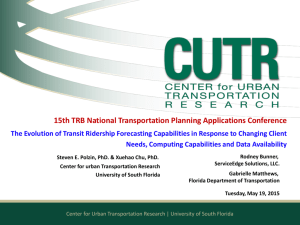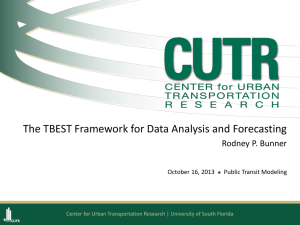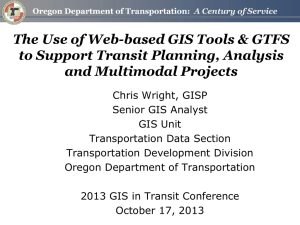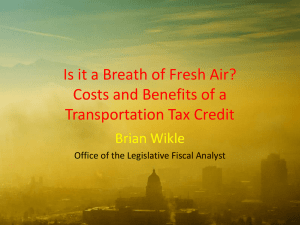The TBEST Framework for Data Analysis and Forecasting
advertisement
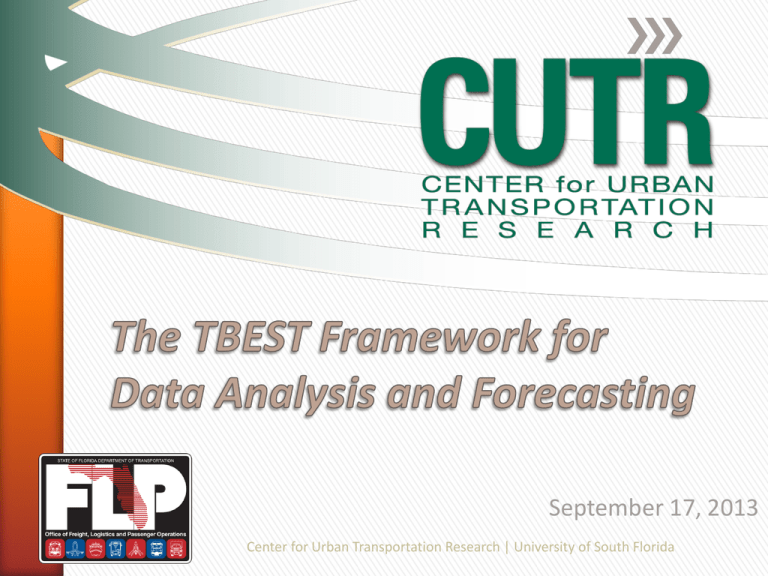
September 17, 2013 Center for Urban Transportation Research | University of South Florida TBEST Transit Boardings Estimation and Simulation Tool Transit Demand Modeling/Analysis Software developed by the Florida Department of Transportation Office of Freight, Logistics and Passenger Operations FDOT Goal Provide a “Comprehensive Transit Network Modeling, Management and Analysis Software with a focus on short to midterm transit planning available to all Florida transit agencies” Support Agency Transit Development Plans (TDP): TBEST is an FDOT approved ridership estimation methodology TBEST Utilization Provide workflow support for the following: • Service Planning • Comprehensive Operational Analysis (COA) • Grant Applications Transit Planning/Forecasting Software • FTA Title VI Analysis Short and • Mobility Studies Operations Long Range mid-term • NTD Route Miles Cube Hastus Voyager Trapeze TBEST • Market Analysis TransCAD Others… Others… • Network Accessibility Framework Components • • • • Model Development Application Analysis Reporting and Output Managing Components TBEST Transit System • Composed of model scenarios which contain editable routes, stops, socio-economic data and network attributes • All GIS/database files managed internally • Download pre-formatted SE data • Managed Model Validation • Customizable model structure • Easily create current or future year scenarios Transit Data Management Supporting Data Dataset Source Socio-Demographic Census 2010 and ACS Employment InfoUSA (or local zonal data) Land Use (Parcel-Level) Florida Department of Revenue Network Download or GTFS Special Generators Agency Socio-Economic Growth Rates Bureau of Economic and Business Research Observed Ridership for Validation Agency FDOT Provided TBEST GIS Specifications • Desktop application requiring ArcGIS 10.1 Basic license • Utilizes ArcGIS Engine for map display, spatial analysis and network editing • ESRI personal geodatabase stores transit layers and socioeconomic data geometry • Demographics, service characteristics, and model output stored in SQL Server 2008 R2 (Express or Enterprise editions) • No Network Analyst or ArcSDE required • Utilizes ESRI Map Services, Bing Maps or preformatted .mxd for base map • No fee for TBEST except ArcGIS license Model Specifications • Micro-level model which simulates transit ridership at the level of the individual stop: by route, direction and time period • Designed to capture both walk market and network accessibility • Model equations estimate direct and transfer boardings • Accommodate service features of fare, speed, frequency, etc. • Accommodate fundamental differences in route types (local, circulator, express) • Model validation process allows TBEST to adapt to different urban locations without developing new model equations (transferable) Model Equations Users are able to maintain multiple model structures which can be applied to model scenarios TBEST is installed with two model structures, the classic TBEST Model which utilizes the Census and Employment data and the new TBEST Land Use Model which includes trip-generation from parcel land use data. Available Models New models coming online in Los Angeles and Oregon – LA model will include specific equations for Bus and Rail – Oregon model will include customization of the parcel level land use model BRT Sensitivity TBEST now supports BRT route definition and model sensitivity How it works Users specify the implementation level of specific route-level BRT characteristics and TBEST will adjust base ridership forecasts with an empirically derived adjustment factor Network Interoperability • GTFS Import – Imported networks for all FL agencies with GTFS feeds – Also used nationally in Ft. Worth, Portland, Los Angeles, Savannah • GTFS Export – Export TBEST network into GTFS – Added TBEST attributes to exported data including ridership and stop amenities • ArcGIS – Export TBEST maps and data into ArcGIS – Import route alignments into TBEST from outside data sources – Export “loaded networks” into geodatabases Scenario Modifications Category Changes Headway Adjustment Operating Strategies Short Turning Route Splitting Through Routing Service Supply Adjustments Running Time Adjustments Schedule Changes Schedule Coordination between Routes Span of Service Adjustments Extend Routes Alignment Changes Shorten Routes New Routes Service Redistribution System Changes Network Structure Demand Adjustments Fare Policy Socio-Economic Forecasts First-Boarding Fare Transfer Fare System level, Zonal level, DRI/Corridor level, Route, Segment or Stop level Model Reporting Stop, Segment, Route and Regional distribution reports with supporting maps Model Reporting Scenario Comparison and Mobility Threshold service recommendations Model Reporting TDP Summary Report Summarizes annual service area pop, employment, performance, and service for all scenarios in a TBEST transit system Market Analysis • Works to summarize the intensity and distribution of land use, socio-economic, and employment data for a given transit market in a current year or future year socio-economic setting • Performed on existing or proposed network structure or within specific DRI’s/corridors to determine the viability of transit options in the area • Independent of the TBEST modeling capabilities Market Analysis Land Use Market Analysis Market Analysis Socio-Economic Market Analysis Market Analysis FTA Title VI Analysis Network Accessibility Analysis • Combines TBEST transit networking origin/destination capabilities with market and model results to produce an interactive summarization of network accessible markets and model output • Network Accessibility Build - core of the accessibility calculation which populates an origin/destination matrix for each stop in the network • Summarizes both outflow and inflow markets and ridership from a selected stop, multiple stops or from a geographic area by time of day • Filter results by trip time and number of transfers Network Accessibility Analysis Network Accessible Market Analysis Implementation Results Win-Win-Win Situation FDOT standardized model platform for consistent TDP ridership reporting across agencies Agencies have a pre-built methodology for estimating ridership + multiple workflow support Consultants using TBEST for TDP, COA, etc. have an easy-to-implement ridership estimation solution with available data, tools and modeling capabilities Steps Underway September 2013 – Release TBEST 4.1 – Contains online Video Tutorials – Classroom training early 2014 January 2014 – Enhanced FTA Title VI and Environmental Justice Analysis and Reporting June 2014 – Parcel Editor – Integrate Observed Ridership for COA support October 2014 – Network Accessibility Composite Measures Contact Information Thank You! www.tbest.org Rodney Bunner Transportation Technology Specialist rbunner@cutr.usf.edu rodbunner@hotmail.com 727-455-4059 Gabrielle Matthews FDOT Project Manager Gabrielle.Matthews@dot.state.fl.us 850-414-4532
